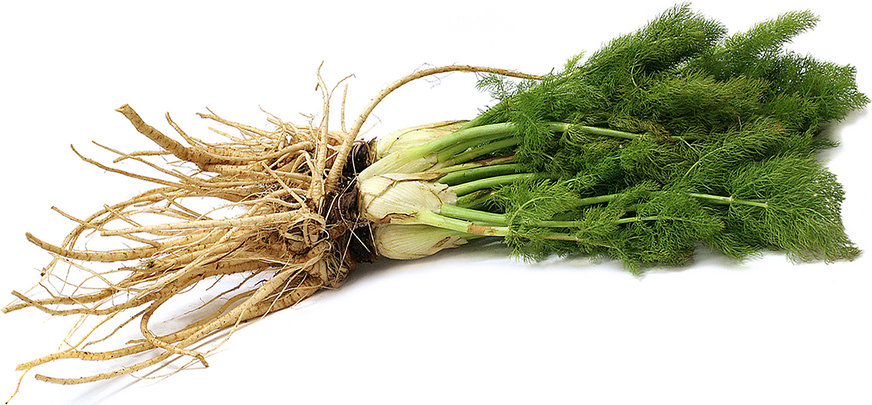


Fennel Roots
Estimated Inventory, bunch : 0
Description/Taste
Fennel roots vary in size depending on the maturity of the plant and the climate it is grown in, but the taproots are elongated, fairly straight, and slender, often developing multiple off-shoots creating large clumps. The semi-smooth skin ranges in color from ivory to tan, similar in appearance to a parsnip and may contain fine hairs across the surface. Underneath the skin, the flesh is crisp, dense, and firm. Fennel roots have a starchy and slightly fibrous texture with an earthy and mildly sweet, anise-like flavor.
Seasons/Availability
Fennel roots are available year-round, with a peak season in the winter.
Current Facts
Fennel roots, botanically classified as Foeniculum vulgare var rubrum, develop from the perennial, non-bulb-forming variety known as Bronze fennel, which produces longer taproots and little to no bulb. Bronze fennel can grow over one meter in height and is primarily cultivated for its herbaceous fronds and aromatic seeds. In addition to the fronds and seeds, the roots are also edible and are utilized on a small scale by home gardeners as a starchy element in soups and stews.
Nutritional Value
Fennel is considered to have anti-inflammatory properties and contains vitamin C, potassium, fiber, and iron, which all contribute to boosting the immune system and maintaining overall health.
Applications
Fennel roots are best suited for cooked applications such as boiling and roasting. The taproots can be diced and roasted with other root vegetables, boiled and sliced into salads, used as an edible garnish on plates, or cooked and pureed into soups as a thickener. The roots can also be used as a thickener in sauces, gravies, and smoothies, or they can be steeped in milk and made into baked goods. In addition to the roots, the leaves and seeds are used as aromatics in both sweet and savory preparations and are sometimes steeped in boiling water to make a tea. Fennel roots pair well with other root vegetables such as carrots, parsnips, or beets, tomatoes, cucumbers, potatoes, onions, garlic, cabbage, and tarragon. The roots should be removed from the small stalks and will keep 1-2 weeks when stored in the refrigerator.
Ethnic/Cultural Info
In the United States, fennel is an essential herb in home gardens as it attracts bees and butterflies, who are the primary pollinators that help fertilize garden plants. Fennel is also a valuable host plant for the Anise Swallowtail and the Eastern Black Swallowtail butterflies. In addition to ornamental use, home gardeners commonly utilize fennel as a natural fence, and medicinally, the leaves are often used in digestive aid teas.
Geography/History
Fennel is native to the Mediterranean region of Europe and has been growing wild since ancient times, used as a medicinal ingredient and flavoring. The plant was then spread to Asia and the New World via explorers, trade, and immigrants. Today Fennel root can be found growing wild in Europe, Asia, and select regions of North and Central America.
Recipe Ideas
Recipes that include Fennel Roots. One
| Good Gut |
|
Butternut Squash & Fennel Root Soup |




